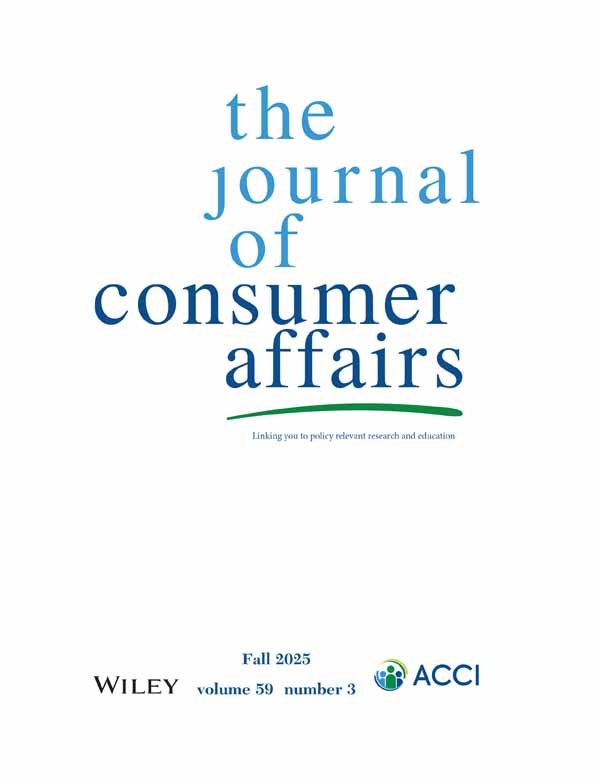Subjective and Objective Criteria in Consumer Choice: An Examination of Retail Patronage Criteria
ELIZABETH C. HIRSCHMAN
Elizabeth C. Hirschman is Associate Director, Institute of Retail Management, and Assistant Professor of Marketing, Graduate School of Business, New York University.
Search for more papers by this authorS. KRISHNAN
S. Kirshnan is Assistant Professor of Marketing, College of Business Administration, Pennsylvania State University.
Search for more papers by this authorELIZABETH C. HIRSCHMAN
Elizabeth C. Hirschman is Associate Director, Institute of Retail Management, and Assistant Professor of Marketing, Graduate School of Business, New York University.
Search for more papers by this authorS. KRISHNAN
S. Kirshnan is Assistant Professor of Marketing, College of Business Administration, Pennsylvania State University.
Search for more papers by this authorAbstract
Traditionally consumer researchers and consumer educators have made a distinction between objective and subjective evaluative criteria for consumer choice. This paper examines the validity of this distinction using data on consumers evaluative criteria for department stores. The study found evidence that consumers use evaluative dimensions composed of both subjective and objective evaluative criteria, suggesting that both types of information are necessary for choosing among department stores.
REFERENCES
- 1 David A. Aaker and George S. Day (eds.), Consumerism: Search for the Consumer Interest, 2nd Ed., New York , The Free Press, 1974.
- 2 Alpert, Mark I., “Identification of Determinant Attributes: A Comparison of Methods,” Journal of Marketing Research, Vol. 8 (May 1971), pp. 184–191.
- 3 Arnold, Stephen J., Sylvia Ma and Douglas J. Tigert, “A Comparative Analysis of Determinant Attributes in Retail Store Selection,” Advances in Consumer Research, Vol. 5, Keith Hunt (ed.). Association for Consumer Research, 1978, pp. 663–667.
- 4 Assam, Edward H. and Louis P. Bucklin, “Nutrition Labeling for Canned Goods: A Study of Consumer Response,” Journal of Marketing, Vol. 37 (April 1973), pp. 32–37.
- 5 Becker, Howard S., “Arts and Crafts,” American Journal of Sociology, Vol. 83, 1978, pp. 862–889.
- 6 Berry, Leonard J., “The Components of Department Store Image: A Theoretical and Empirical Analysis,” Journal of Retailing, Vol. 45 (Spring 1969), pp. 3–20.
- 7 Dyer, Robert F. and Phillip G. Kuehl, “The ‘Corrective Advertising’ Remedy of the FTC: An Experimental Evaluation,” Journal of Marketing, Vol. 38 (January 1974), pp. 48–54.
- 8 Engel, James F., David T. Kollat and Roger D. Blackwell, Consumer Behavior, Second Edition, New York , Holt, Rinehart and Winston, 1973, p. 29.
- 9 Gardner, David M., “Deception in Advertising: A Conceptual Approach,” Journal of Marketing, Vol. 39 (January 1975) pp. 40–46.
- 10 Garman, E. Thomas and Sidney W. Eckert, The Consumer's World(Resource), New York , McGraw Hill Book Company, 1974.
- 11 Grubb, Edward L. and Harrison L. Grathwohl, “ Consumer Self Concept, Symbolism and Market Behavior: A Theoretical Approach,” in Consumer Behavior in Theory and in Action, Stuart H. Britt (ed.), New York . John Wiley and Sons, Inc., 1970, pp. 161–163.
- 12 Holbrook, Morris B., “Beyond Attitude Structure: Toward the Informational Determinants of Attitude,” Journal of Marketing Research, Vol. 15 (November 1978), pp. 545–556.
- 13 Jacoby, Jacob and Constance Small, “The FDA Approach to Defining Misleading Advertising,” Journal of Marketing, Vol. 39 (October 1975), pp. 65–73.
- 14 King, Charles W., “Local Market Monitoring: Strategic Implications,” Advances in Consumer Research, Vol. 5, H. Keith Hunt (ed.), Association for Consumer Research, 1978, pp. 683–692.
- 15 Lindquist, Jay D., “Meaning of Image,” Journal of Retailing, Vol. 50 (Winter 19741975), pp. 29–38.
- 16 May, Eleanor G., “Practical Applications of Recent Retail Image Research,” Journal of Retailing, Vol. 50 (Winter 19741975), pp. 15–20.
- 17 Ogden, C. K. and I. A. Richards, The Meaning of Meaning, New York , Harcourt, Brace & World, 1923.
- 18 Olshavsky, Richard W. and J. A. Miller, “Consumer Expectations, Product Performance and Perceived Product Quality,” Journal of Marketing Research, Vol. 9 (February 1973), pp. 19–21.
- 19 Osgood, Charles E., George J. Suci and Percy H. Tannenbaum, The Measurement of Meaning, Urbana : University of Illinois Press, 1957.
- 20 OSIRIS III, Vol. 1, System and Program Description, Ann Arbor : Institute for Social Research, 1973, pp. 627–636.
- 21 Peterson, Robert A., “ Consumer Perceptions as a Function of Product Color, Price and Nutrition Labeling,” in Advances in Consumer Research, Vol. 4, William D. Perreault (ed.). Association for Consumer Research, 1977, pp. 61–63.
- 22 Ring, Lawrence J. and Charles W. King, “ A Multiple Discriminant Analysis Approach to the Development of Retail Store Positioning,” Advances in Consumer Research, Vol. 5, Keith Hunt (ed.), Association for Consumer Research, 1978, pp. 227–238.
- 23 Rommetviet, R., Words, Meanings and Messages: Theory and Experiments in Psycholinguistics, New York , Academic Press, 1968.
- 24 Scammon, Debra L., “Information Load and Consumers,” Journal of Consumer Research, Vol. 4 (December 1977), pp. 148–155.
- 25 Swan, John. E. and Linda Jones Combs, “Product Performance and Consumer Satisfaction: A New Concept,” Journal of Marketing, Vol. 40 (April 1976), pp. 25–33.
- 26 Jack L. Taylor, and Arch W. Troelstrup, (eds.), The Consumer: Additional Dimensions, New York : McGraw Hill Book Company, 1974.
- 27 Timasheff, Nicholas S. and George A. Theodorson, Sociological Theory: Its Nature and Growth, Fourth Edition, New York , Random House, 1976.
- 28 Thorelli, Hans B., “ Philosophies of Consumer Information Programs,” Advances in Consumer Research, Vol. 4, William D. Perreault (ed.) Association for Consumer Research, 1977, p. 283.
- 29 Wiikie, William L. and David M. Gardner, “The Role of Marketing Research In Public Policy,” Journal of Marketing, Vol. 38 (January 1974), pp. 38–47.




